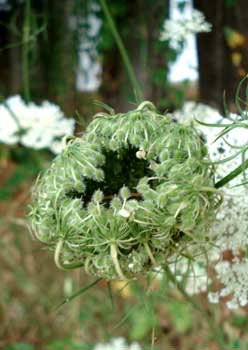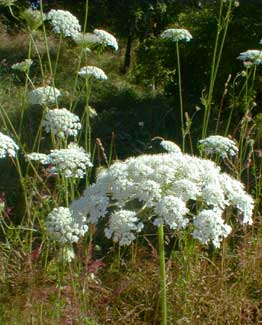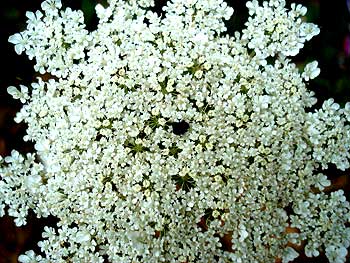
Queen Anne's Lace
"Her lawn looks like a meadow,
And if she mows the place
She leaves the clover standing
And the Queen Anne's lace!"
-Edna St Vincent Millay
(1892-1950)
(1892-1950)
"Queen Anne's Lace dandies up
a ditch, like embroidered hankies
in a farmer's pocket."
-Terri Kirby Erickson,
2007
2007
 The ubiquitous biennial summer wildflower Queen Anne's Lace (Daucus carota ssp carota) is common throughout North America, though originally from Europe & Asia. We see it alongside roads & in fields throughout the Pacific Northwest, selecting the sunniest of sunny spots & often springing right up out of the hardest of packed soils it's so unfussy.
The ubiquitous biennial summer wildflower Queen Anne's Lace (Daucus carota ssp carota) is common throughout North America, though originally from Europe & Asia. We see it alongside roads & in fields throughout the Pacific Northwest, selecting the sunniest of sunny spots & often springing right up out of the hardest of packed soils it's so unfussy.It's also called Wild Carrot, since the domestic carrot is a variant or subspecies of the same species (D. carota ssp sativa). It's probable that Queen Anne's Lace arrived in North America with the first European settlers as a food plant; it is by now naturalized across the continent.
Queen Anne's Lace or Lace Flower is of course named for the lacecap blossom which, on close examination, is a compound umbel made up of several smaller lacecaps.
According to legend, Queen Anne, wife of King James I, challenged her lady's-in-waiting to a contest to see who best could produce a piece of lace as beautiful as a carrot's flower. No one could out-match the young queen. However, just as she finished, she accidentally pricked her finger with a needle, for which reason Queen Anne's Lace has a single red flower right at the center.
 At first glance the Queen Anne's Lace looks completely white, but if you look at the center, there indeed is that central maroon-brown to purple blossom! Just one, so tiny it's easily unseen.
At first glance the Queen Anne's Lace looks completely white, but if you look at the center, there indeed is that central maroon-brown to purple blossom! Just one, so tiny it's easily unseen.It's alternately called Bird Nests because as the flower dries & goes to seed, it curls upward forming a near-globe with bird-access in the middle, drying into the shape of a bird's nest. They're occasionally called Bee's Nests because pollinators of several kinds will be seen crawling over the umbels in July.
An old European name for Queen Anne's Lace is Devil's Plague, because so difficult to control. The folkname Rantipole meaning a reckless wild boy or girl with rude manners, likewise alluding to their devilish aggressiveness.
In our area they are in full bloom in every super-sunny location by mid to late July. The numbers of their blossoms declines in August but a few are apt to be seen as late as September. It self-seeds with extravagant abandon, but it is not as fond of well-watered gardens, so though it can be a pest-plant across the countryside, it is not too much a garden invader. It's also so intolerant of shade that even moderate shade keeps it out of the garden, though it will sometimes invade a never-mowed lawn.
Besides D. carota carota & its domestic form D. carota sativa, there are two other variants, D. carota roseus with pinkish to purple blooms instead of white, & D. carota epurpuratus of purer white lacking the maroon eye. There is additionally the native D. pusillus or American Wild Carrot, found in the Northwest & southwest & American south, but it is much smaller & less impressive than the three to five foot tall Queen Anne Lace (occasionally taller) which makes the native look-alike appear to be a midget. Queen Anne's Lace additionally resembles wild caraway (Carum carvi).
The edible root of the wild carrot is thin, pale, & much more difficult to get a good harvest from compared to a fat domestic carrot, but can be worth the trouble because quite flavorful. There are however some toxic look-alike plants such as Poison Hemlock or Fool's Parsley (Conium maculatum) or Water Hemlock (Cicuta maculata), so take care with wild collecting. The wild carrot is the only one which has the maroon central flower.
Traditionally a tea made from Queen Anne's Lace was used to treat diabetes, but when scientific research got 'round to testing its efficacy, it had none. Teas made from various parts of the plants including roots, leaves, blooms, & seeds have been variously used for everything from dropsy to kidney disease to scurvy.
Most of its traditional uses turn out not to be valid, though its use for treating mild cases of worms may have some faint foundation. And very broadly speaking, Queen Anne's Lace is a bacteriacide, is rich in vitamins, plus it has chemical components that have been proven to function as an abortifacient, like a morning-after pill, which is perhaps a warning to women attempting to get pregnant. An additional warning goes to who has had allergenic skin reactions to chrysanthemums or celery, as they will likewise be susceptible to dermatitis if exposed to Queen Anne's Lace.